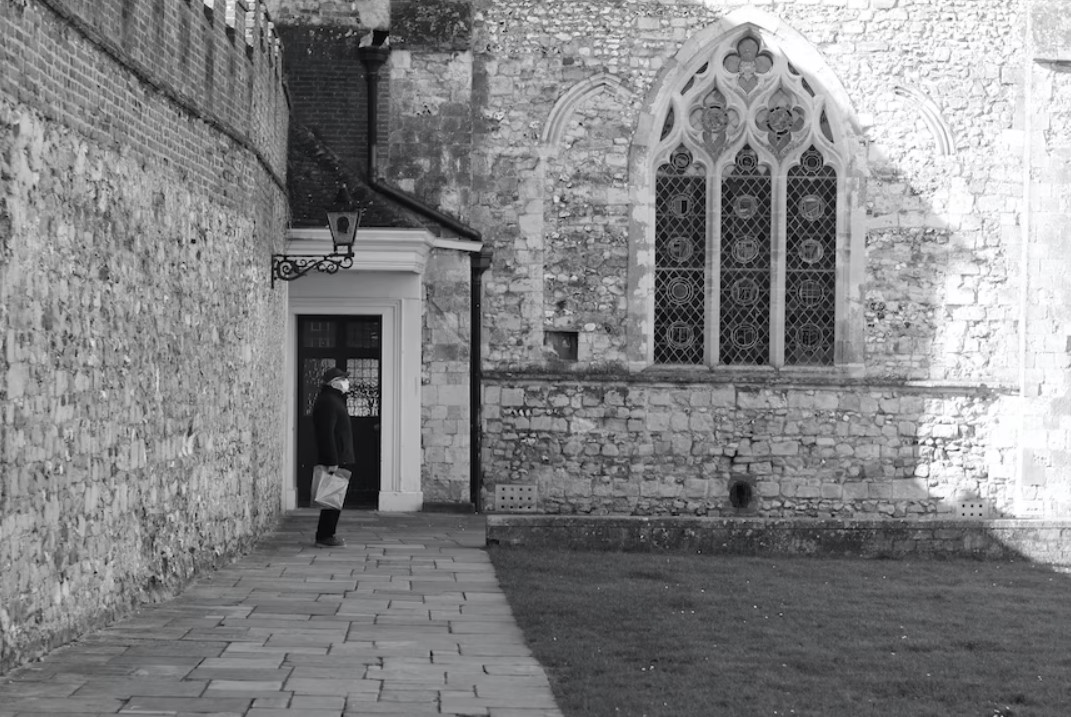Read the contextual analysis of the poem Eve of St Agnes by John Keats, a poem that is considered Keats’ first poem of the ‘Creative Period’, a time that is considered to be the moment in his life when he wrote his most brilliant poems. It was inspired by his initial passion for Fanny Brawne, the woman who became his fiancee and remained dedicated to him even after his death. It was thought to be written between the end of January and the beginning of February 1819, when visiting friends in Chichester. Many of the classic gothic images of the poem are thought to have been taken directly from a visit to Chichester Cathedral, which is known for its Gothic architecture and stained glass windows.

Chichester Cathedral, Chichester UK; photo by Simon Haslett on Unsplash
Keats himself called it a “little poem”, not considering it one of his best, and editors asked him to tone down the sexual references as they feared it would be off-putting to their readers.
Eve of St Agnes – Setting and Narrative Voice
St Agnes’ Eve: A European folk superstition where a girl can see her future husband in a dream when performing rituals on the Eve of St Agnes (20th January). St Agnes Day is the 21st of January; Agnes was a young girl who refused to worship pagan gods and was killed for her faith in Christ – she is considered a Patron Saint of young girls and innocence. She was dragged naked through the streets to a brothel because of her refusal to renounce Christianity, and the men who saw her in the brothel were all struck blind. The ritual states that if a virgin woman goes to bed without supper, lies naked on her bed with her hands under the pillow and her eyes turned towards the heavens, then her future husband will appear in her dreams, kiss her and feast with her.
Medieval Dream Visions – Romantic poets revived the medieval tradition of incorporating dream visions into literature – a dream vision originally was a form of writing in which a protagonist fell asleep and then entered a dream, by which divine knowledge or truth was revealed to them. In a way Madeleine’s ritual functions similarly to this device – she is in a dreamlike state, then falls asleep and upon waking feels that she has already dreamt of Porphyro as her true love.
“La belle dame sans mercy” – The name (almost – “La Belle Dame sans Merci” is the proper title) of a poem by Alain Chartier, written in 1424, and also, more famously, the title of another Keats poem. The translation of the song’s title is “the beautiful woman without pity.” However in some ways Keats’ ‘La Belle Dame sans Merci’ is essentially the total opposite of The Eve of St. Agnes – the “faery’s child” in his poem turns out to be a trickster who leaves the knight she seduces “alone” and sick with longing, whereas here the interpretations are either that Porphyro is the trickster, or that both lovers are truly happy with one another.
Romanticism – Keats was a Romantic poet, and much of his works incorporate the rich sensuality that is characteristic of Romantic literature – he certainly views human beings as capable of feeling intense emotions that are in many ways transcendent and put a person into direct contact with the spiritual or the divine. Romantic poets often rejected traditional structures of society, which they viewed as oppressive and a barrier to the freedom of the individual; here that can be seen through Keats’ dislike of the partygoers, who all have traditional values and beliefs – the love the Madeleine and Porphyro have for one another transcends their backgrounds and their upbringing.
| TASK: Read the following letter, written by Keats to his fiancee, Fanny Brawne, in October 1819. He wrote the Eve of St Agnes in the dead of Winter 1818-1819 and published it in 1820. How do the ideas he conveys to Fanny below translate into the poem?
My dearest Girl, This moment I have set myself to copy some verses out fair. I cannot proceed with any degree of content. I must write you a line or two and see if that will assist in dismissing you from my Mind for ever so short a time. Upon my Soul I can think of nothing else — The time is passed when I had power to advise and warn you against the unpromising morning of my Life — My love has made me selfish. I cannot exist without you — I am forgetful of every thing but seeing you again — my Life seems to stop there — I see no further. You have absorb’d me. I have a sensation at the present moment as though I was dissolving—I should be exquisitely miserable without the hope of soon seeing you. I should be afraid to separate myself far from you. My sweet Fanny, will your heart never change? My love, will it? I have no limit now to my love — Your note came in just here — I cannot be happier away from you — ’T is richer than an Argosy of Pearles. Do not threat me even in jest. I have been astonished that Men could die Martyrs for religion — I have shudder’d at it — I shudder no more. I could be martyr’d for my Religion — Love is my religion — I could die for that — I could die for you. My Creed is Love and you are its only tenet — You have ravish’d me away by a Power I cannot resist; and yet I could resist till I saw you; and even since I have seen you I have endeavoured often “to reason against the reasons of my Love.” I can do that no more — the pain would be too great — My Love is selfish. I cannot breathe without you. Yours for ever John Keats |












